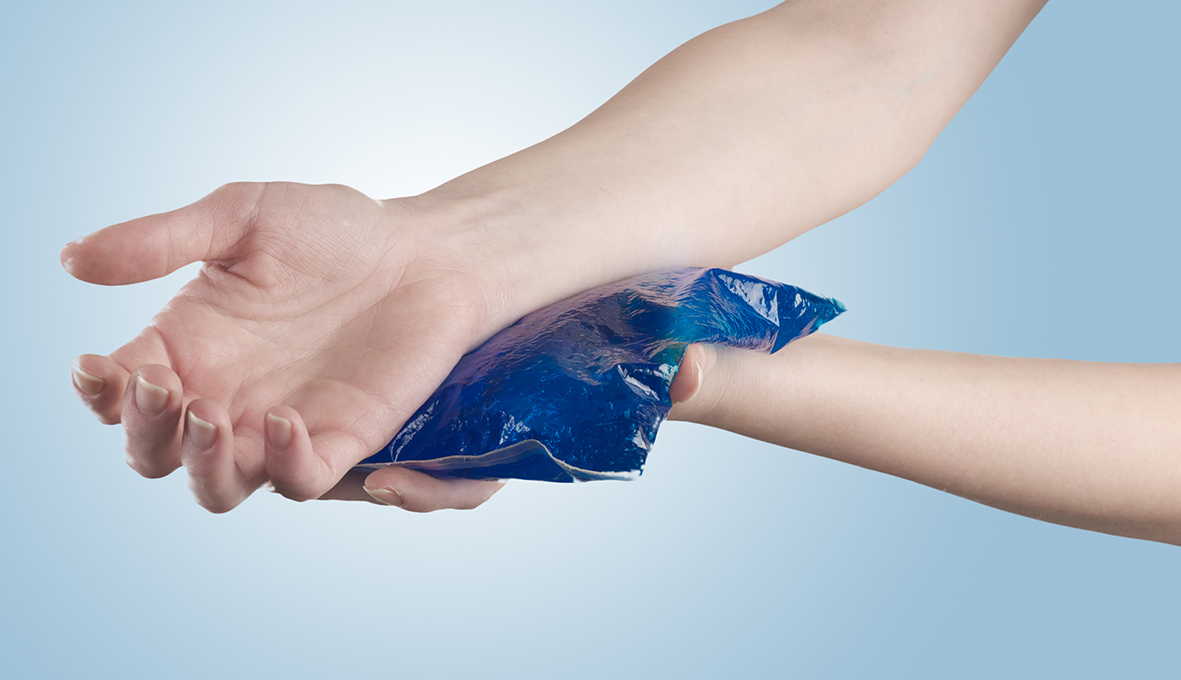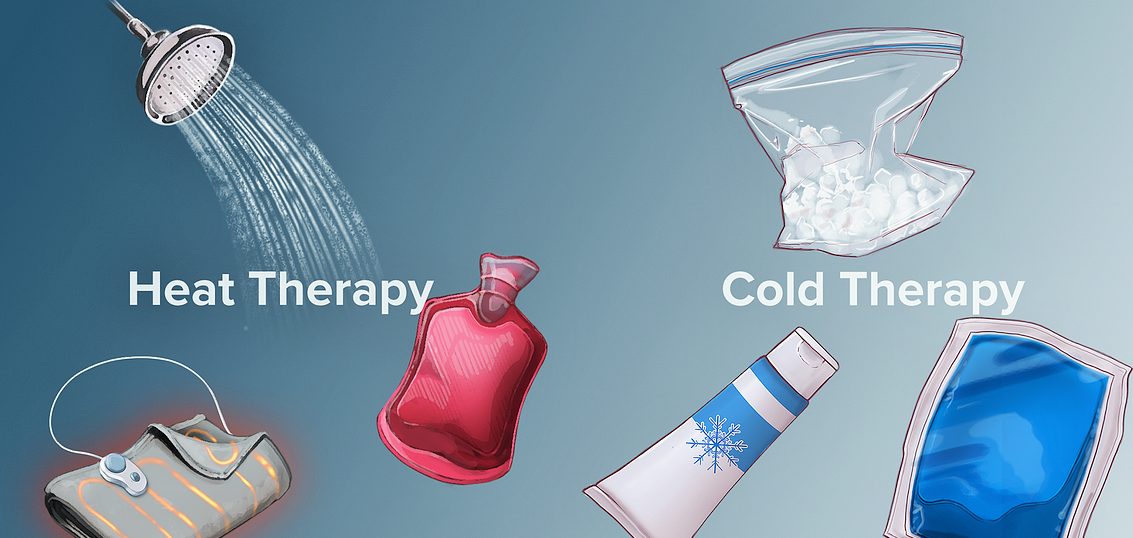Alternating ice and heat therapy: A complete guide 2023
There is a lot of buzz about the benefits of hot and cold therapies, but do you know how they work or when they work best? When exactly should you not be using it?
Most importantly, what type of cryotherapy or thermotherapy is needed? Which one is suitable for your injury, considering the accident’s intensity, location, and duration?
Alternating ice and heat therapy is the best and easiest way to treat swellings, pain, and injuries. You will learn about the benefits, how to do it, and safety precautions.
Well, you should know that they can be used simultaneously, for the same injury, on the same body part! This method is called contrast therapy. This technique involves alternating heat and ice for pain management, inflammation, swelling, and many other problems caused by the injury (sports, accidents), medical condition, or overexertion.
Both hot and cold therapies have their pros and cons. Contrast therapy is considered a safe, reliable option that’s also pretty affordable.
The best part is that you can perform this low-risk and straightforward treatment at home for instant and medication-free relief. It is found equally effective for most pains.
We can say contrast therapy is a feasible and cheap solution to minimize inflammation along with relaxing muscles. Time to enjoy natural pain relief!
Remember: Perseverance is key to having an efficacious contrast therapy for complete healing.
- UNIVERSAL WRAP TO RELIEVE WHAT AILS YOU
- HOT WATER THERAPY HAS MANY BENEFITS
- ADD ICE FOR CIRCULATING WATER THERAPY
- A HOT AND COLD WATER THERAPY MACHINE TO HELP MANAGE PAIN
How does the hot and cold therapy system work?
Contrast therapy uses a perfectly balanced mix of ice and heat for treating soreness and pains. But if we talk about the overall process, cold and hot treatments work differently. They work on separate mechanisms and have different effects. Let’s have a quick overview of their work!
Ice for Injury – Cryotherapy
In cryotherapy, you use either ice or freezing temperatures for therapeutic purposes. It works by directly affecting the the vessels and causing rapid vasoconstriction. It plays an efficient role in lowering or limiting inflammation by confining blood flow to the damaged part.
This narrowing of the blood vessels makes the muscles contract. As soon as vessels constrict, the pain signals get reduced. Moreover, due to constriction as a result of icing, swelling is reduced.
Ice numbs your aching part, letting you have a sigh of relief. It acts as your local anesthetic. Cold therapy calms down your inflamed tissues, decreasing pain and tissue damage.

Heat for Injury – Thermotherapy
Cold therapy works by constricting the vessels, and on the other hand, heat supports the dilation of vessels. It works the opposite way from the cold. By vasodilation, it maintains healthy blood, nutrients, and oxygen flow to the damaged area. Heat therapy is a vasodilator, which increases circulation by expanding the vessels. Thermotherapy decreases pain and helps you get rid of cramping and painful muscles.
By sufficient supply of every essential element, it aids in the healing process. It works by enabling your body’s cells to eliminate waste products.

Summary
In short, upon application of cold, vasoconstriction occurs, reducing the circulation. It is followed by heat treatment, where vasodilation happens. The veins expand to overcompensate, improving circulation and the incoming flow of nutrients for healing injured tissues. This is known as alternating ice and heat therapy.
Hot and cold therapy benefits
Cryotherapy
- Ice therapy relieves inflammation.
- If you expose yourself to extremely low temperatures after a hard workout, you will be able to decrease tissue damage.
- Support faster recovery
- Ideal for relieving acute pain
- Beneficial for people who are suffering from a nagging injury as the cold temperature is capable of decreasing pain during flare-ups
- Reduces swelling
- Numbs nerve receptors for instant pain management
- Eliminates dead blood cells from the body
- Ice is most effective within 48 hrs. of an injury.
- It is used as a standard treatment in case of any sports injury.
Thermotherapy
- Ideal for pre-workout injury prevention as it warms up your muscles and joints
- Useful in chronic pain treatment
- Supports steady oxygen flow to the painful muscles
- Relaxes stiff joints and stressed muscles
- Speeds up healing time
- Safe option for pregnant women
Contrast therapy timing
Are you interested in contrast therapy? The first thing you need to know is that it should be done carefully, considering the duration. You can select your preferred delivery method. But don’t forget to keep a clock or stopwatch with you to keep an eye on the time.
Typically, contrast therapy is used in a ratio of 1 minute of cold to 3–4 minutes of heat. It is safe to repeat the heat/cold cycle three times. The main focus at the beginning and end of the treatment is to limit inflammation; that’s why we use ice first. The basic pattern followed for the application of contrast therapy is:
1 minute – cold therapy
3 minutes – heat therapy
1 minute – cold therapy
3 minutes – heat therapy
1 minute – cold therapy
3 minutes of heat– cold therapy
1 minute – cold therapy (always finish with cold)

Alternating heat and ice for a sprained ankle
Alternating heat and ice for sprained ankles is a good option, but it is recommended to apply ice first. If it doesn’t work out and you feel no change in pain or swelling, you can opt for contrast therapy.
The treatment will be based on RICE (rest, ice, compression, and elevation) in the initial 48 to 72 hours of contrast therapy. You place the ice on the ankle for approximately 10–15 minutes. Once the time has passed, or the swelling has been reduced, you can switch to heat. Because your ankle now requires a constant supply of blood in order to heal quickly.
The primary reason for choosing ice over heat is its tendency to stop the blood flow, reducing swelling. In contrast, the heat improves flow, increasing the chances of swelling. Moreover, after a couple of days, your body gets more susceptible to the cold, and you will experience no further improvements in symptoms.
Hot and cold therapy for shoulder pain
For a Frozen Shoulder
Use a simple ice pack to minimize the local inflammation and swelling. Keep icing your shoulder for at least 10 minutes, and do it daily before hitting the bed.
For Osteoarthritis
Both Hot and cold therapies are recommended. A combination best treats inflammation and pain. Apply heat for 20-30 minutes before exercising and cold for 20-30 minutes afterward, with breaks every four to five hours.
For bursitis
For bursitis, biceps tendonitis, impingement, and rotator cuff tendonitis place a cold pack and leave it on the shoulder for 15-20 minutes every 3-5 hours. Start using heating packs for the shoulder ONLY when the ache and inflammation are improved.
Contrast therapy: When should it be avoided?
- Acute (recent) injuries (should not be exposed to heat or contrast therapy)
- An open wound or skin issues (bleeding and infection issues)
- No heat therapy if the skin is hot red or inflamed
- Circulatory and heart conditions
- Cold urticaria (body reacts adversely to cold-forming hives)
- Fever or infection
- Dermatitis blistered skin, or any significant skin problem
- Peripheral neuropathy and diabetic neuropathy
- Having any vascular disease or sympathetic dysfunction
- Heat or cold hypersensitivity
- Raynaud’s syndrome (Cold treatments worsen the condition)
Which Injuries Does Contrast Therapy Work Best For?
- Muscular strains and sprains (elbow, knee, ankle, foot, wrist, shoulder, and neck)
- Swelling (cold therapy preferably)
- Menstrual and muscular Cramps or spasms
- Aching joints
- Chronic lower back pain
- Repetitive-strain injuries, including tendonitis
- Hip joint problems limiting the mobility and ROM
- Sports or athlete injuries
- Flare-ups of chronic conditions (arthritis, Rheumatoid arthritis, or fibromyalgia)
- Pains caused due to cancer (in some instances)
- Eye pain or inflammation (heat therapy preferably)
Precautions
- Never apply ice or heat packs directly to the skin. Always keep a thin fabric between the source and the skin.
- Never use a heating pad for an open or bleeding wound.
- Be careful about overheating, or else skin burns can occur
- Keep the temperature of a heating pack low or medium
- Ice application should be made within the required time limit as ice tenses your muscles worsening the pain
- Take intervals between using cold or hot packs
- People with cognitive or communication difficulties are not suitable for any therapy.
- Contrast therapy leads to quick temperature changes causing dehydration, so make sure you are taking enough liquid. Stay hydrated!
- Stretch your muscles only during the warmth or hot stages of contrast therapy
- Always begin and finish with cold therapy
- Never sleep on heated or ice packs
- You should use a heating pad for only 15-20 minutes and then take a break
- If you feel slight discomfort, hot, or pain, do not use it. Alternatively, you can use moist heat.
How long do you alternate heat and ice?
It depends on the intensity of the pain. We can opt for ice therapy in the initial phases for 72 hours or up to 4 days. After that, the patient can safely switch to heat therapy, which would help increase the circulation to the targeted or damaged area.
For ice packs, never put them longer than 15-20 minutes at a time. For continuous switching, use the heating pack for a maximum of 20 minutes, followed by the ice packs for 15 minutes.
Should we use a hot or cold compress for swelling?
For swelling, always choose cold therapy.
A warm compress can help improve sustainable blood flow. It can also help with quick healing, but excessive blood and nutrient flow can result in swelling. Following a general rule of thumb, ice is a suitable choice for treating swelling caused by acute injuries or pain.
Cold compression reduces blood flow, reduces swelling, and reduces pain. You can use any source, such as ice packs, baths, or machines. You should use ice regularly for about half an hour at a time for effective results.
Conclusion
Ice can worsen muscle tension, cramps, and spasms, while heat can increase swelling and inflammation. Cold therapy seems to help in vasoconstriction, but heating supports vasodilation – absolutely opposite! But the point to ponder is “BOTH ARE EQUALLY EFFECTIVE.”
Both have been proven to work. However, further research needs to be done on contrast therapy.
Contrast therapy appears to minimize the morning stiffness, speed up the healing process, decrease post-activity fatigue, and the list continues.
- UNIVERSAL WRAP TO RELIEVE WHAT AILS YOU
- HOT WATER THERAPY HAS MANY BENEFITS
- ADD ICE FOR CIRCULATING WATER THERAPY
- A HOT AND COLD WATER THERAPY MACHINE TO HELP MANAGE PAIN
Additional Questions
What is the recommended duration for alternating between ice and heat?
In typical scenarios, it’s advised not to apply ice for more than 15 to 20 minutes at one sitting. Consequently, *don’t sleep with the ice in contact with your skin*, as prolonged exposure can have harmful effects. As for heat compresses, a similar guideline exists with a recommended 15-20 minutes per session. Following this, you can swap to an ice treatment for 10 to 15 minutes several hours later. As someone who has experienced a sports injury, I can personally vouch for this regimen and its effectiveness on the recovery journey. Make sure to always protect your skin with a towel or something similar during both treatments.
Can alternating hot and cold assist in reducing inflammation?
Yes, the practice of shifting between hot and cold treatment is also known as contrast therapy and it has been shown to help minimize inflammation. Essentially, *contrast therapy promotes lymph fluid circulation* because the warms relaxes and the cold causes contraction. This creates a pump-like action in your lymph system which aids in healing through improved circulatory dynamics. I’ve seen some wonderful outcomes in my own practice as a physical therapist using this method with athletes and patients.
Is it acceptable to alternate between ice and heat?
Interestingly, in some cases, a combination of both approaches can be quite beneficial. Alternating heat and cold has been shown to *enhance blood circulation* to the pain site, which can promote healing. Sharing from my own experience as a physiotherapist, we often deploy both methods alternately on patients undergoing recovery from injuries, and it’s remarkable how much it aids in speeding up the healing process.
What should be the duration for the ice application when alternating?
If you’re alternating with heat, the standard recommendation is to apply ice for about 20-30 minutes, followed by at least a 10-minute break. This should be repeated at least four times daily – although enduring one-hour intervals, especially if the discomfort is acute, is not unheard of. However, if the direct application of the ice for 20-30 minutes proves too intense, you can apply it for a shorter period of 10 minutes, take a brief two-minute break, and then reapply. I’ve used this modified approach with various clients who find the sensation of the cold application to be overwhelming with a longer duration.

Annika Ramos is a physiotherapist with a passion for helping people recover from injuries and illnesses. In her spare time, she enjoys exploring her creative side through various craft projects.


